Himachal Pradesh is known for its natural beauty and divine presence. It is called “dev bhoomi” due to the abundance of deities. Three out of the five “panch kailash” namely Manimahesh Kailash, Kinner Kailash, and Shrikhand Mahadev Kailash, are located in Himachal Pradesh. Every year, during the Savan month, pilgrims undertake tough yatras to these Kailash. These Kailash yatras are physically demanding but hold great significance. In this article you will get complete information about these sacred journeys.
Manimahesh Kailash
Manimahesh Kailash, also known as Chamba Kailash, is a sacred peak in Himachal Pradesh, India. Standing at 5,653 meters (18,547 ft), it is believed to be Lord Shiva’s abode. Located in the Bharmour subdivision, it is a popular pilgrimage site and trekking destination. The peak overlooks the stunning Manimahesh Lake at 3,950 meters (12,960 ft), revered by the locals, especially the Gaddi tribe. Annually, a significant fair is held during the month of Bhadon, attracting numerous pilgrims. Not yet conquered by mountaineers, Manimahesh Kailash remains a pristine and untouched peak.
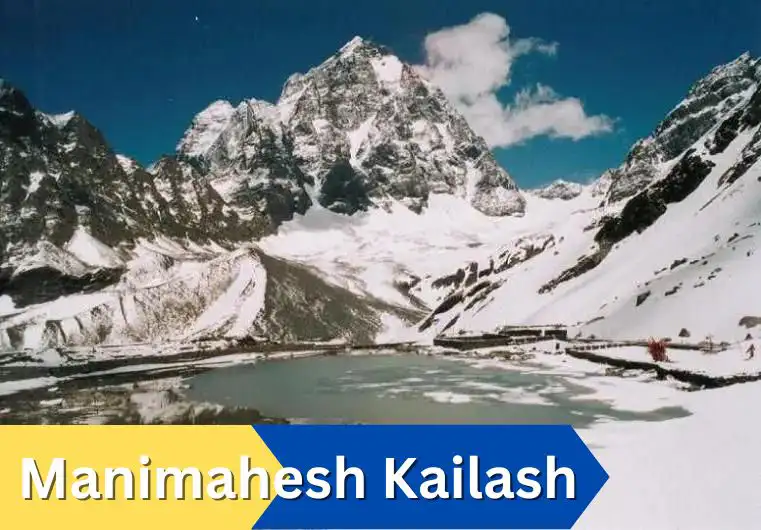
History of Manimahesh Kailash
According to legends, Lord Shiva himself performed intense meditation at this sacred site for many years. Mount Manimahesh Kailash is considered a significant pilgrimage site in the Sanatan Dharma tradition, based on historical and mythological evidence. People have been undertaking this pilgrimage for thousands of years. In mythological texts and literature, it is referred to as Vaiduryamani or Neelmani Parvat, while in English literature, it is known as Turquoise Mountain.
Manimahesh Kailash Yatra
Situated at an altitude of 4,080 metres, Manimahesh lake is considered to be of equal importance to Lake Mansarovar. Manimahesh literally means “Ornament of Shiva”. Manimahesh Yatra remains closed for most of the year due to snowfall. To reach the lake, tourists and pilgrims have to trek for 13 km through enchanting mountains and greenery.The Manimahesh Kailash Yatra, which runs from Janmashtami to Radhashtami (a period of 15 days), is performed in the month of August and September. The path goes through the following places.
Hadsar
The journey to Manimahesh Kailash begins at Hadsar, which serves as the starting point for the Kailash Yatra . At Hadsar, several langars (community kitchens) warmly welcome and support the pilgrims embarking on the Manimahesh Kailash yatra. From this point onward, the path primarily consists of steep terrain, following the course of Gauri Nala that originates from the majestic Manimahesh peak.
Dhancho
As you ascend, you leave behind the tree-covered landscape and pass through birch trees and bushes. Eventually, you reach the alpine meadows of Dhancho. Across the Gauri stream, you can spot many campsites, which are located near a beautiful waterfall in Dhancho. Dhancho means the prominent waterfall among the waterfalls. According to legend, Shiva sought refuge behind the caves near this waterfall while escaping from Bhasmasur. Lord Vishnu transformed into Mohini and put an end to Bhasmasur, allowing Shiva to safely emerge from this spot.

Gauri Kund
Gaurikund, an important stop on the Manimahesh Kailash Yatra, holds great significance for women. It is the place where Mother Parvati performed penance to attain Lord Shiva. Only women are allowed to visit and take a holy bath at this location during the Manimahesh Kailash Yatra. There is a belief that if a woman bathes in the kund with dirty clothes or throws clothes into the kund, its water dries up. It is also said that when a devotee carrying Ganges water passes near the kund, the water in the kund starts to ripple or bounce.
Manimahesh Lake
The pristine Manimahesh Lake is primarily fed by the melting snow from the surrounding snow-capped peaks. As the end of June approaches, the snow starts to melt, forming numerous small streams that eventually flow into Manimahesh Lake. The valley, adorned with lush green hills and blooming flowers, presents a breathtaking natural beauty akin to paradise. The crystal-clear water of Manimahesh Lake reflects the majestic snow-capped peaks, creating a mesmerizing sight. The atmosphere surrounding the lake is pure and sacred, resonating with the prayers of pilgrims and the divine blessings of the Lord.
Kamal Kund
At the base of Manimahesh Kailash lies Kamal Kund Glacier, which gives rise to a stunning lake called Kamal Kund. This radiant lake is located approximately 4 kilometers away from Manimahesh Lake.
How to do Manimahesh Kailash Yatra ?
Trek From Hadsar to Kailash
To embark on the Manimahesh Kailash Yatra, one must first reach Bharmour, which serves as the base for the pilgrimage. Bharmour is home to the revered Mata Bharmani Temple and the Chaurasi Temples. Hadsar, located 10 kilometers away from Bharmour, marks the starting point of the yatra. It is advisable to park your vehicle in Bharmour and opt for a shared taxi, as the road from Bharmour gets congested with parked vehicles during the yatra.
Helicopter Service
If you prefer not to undertake the long trek of the Kailash Yatra or wish to enjoy the breathtaking landscapes of Manimahesh from the air, you have the option of taking a helicopter ride. Helicopter rides for the Manimahesh Kailash Yatra can be booked from Bharmour. The helicopter will transport you to Gauri Kund, from where you will need to trek a distance of 1 kilometer. The approximate cost for a helicopter ride is Rs 15,000. This allows you to conveniently experience the beauty of Manimahesh without the challenges of a lengthy trek.
How To reach Bharmour ?
You can reach Bharmour in your own vehicle or you can take taxi or bus from Chamba town. Private and government bus service is available from chamba.
How to reach Chamba ?
Chamba can be reached by bus from Pathankot and Kangra, as it is accessible only by road. The nearest railway station to Chamba is Pathankot Railway Station, while the nearest airport is Gaggal Airport in Kangra.
Best Time To Visit Manimahesh Kailash
Situated at an elevation of 4,080 meters above sea level, Manimahesh Lake remains frozen throughout the winter season. However, you can plan your visit to Manimahesh Lake between April and mid-November when the weather is more favorable. One of the highlights is the annual fair held in the month of Bhadon (August-September), which draws thousands of pilgrims. This is an opportune time to experience the spiritual atmosphere and witness the grandeur of Manimahesh Lake.
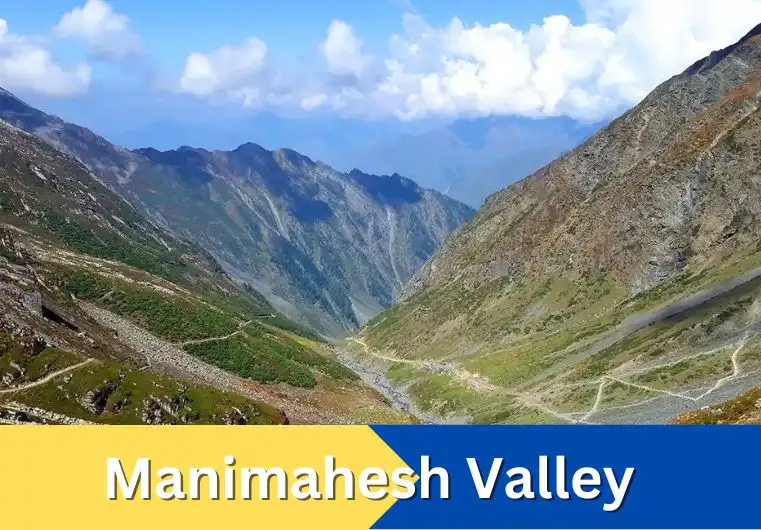
Staying Options in Manimahesh Kailash Yatra
During the official Manimahesh Kailash yatra time you will get plenty of staying options. Locals set up small shops where you can have food and stay options for reasonable prices. Apart from this many langars are run by people where they provide you food and stay options.
Number of days required for Manimahesh Kailash Yatra
This yatra usually requires 1 night 2 days from Hadsar to Hadsar
Day 1
Hadsar – Gauri Kund
Day 2
Gauri Kund – Manimahesh Lake- Hadsar
People with slow pace can cover this yatra in 2 night 3 days
Day 1
Hadsar – Dhancho
Day 2
Dhancho – Manimahesh Lake- Dhancho
Dhancho – Hadsar
2 Shrikhand Kailash
Shrikhand Mahadev located in Kullu, Himachal Pradesh is a special place for Hindu pilgrims. People believe that it is where Lord Shiva and Goddess Parvati live. The journey to reach there is known as one of the most difficult treks in India. At the summit of the mountain, there is a huge Shivalingam that stands 75 feet tall. It is situated at a very high altitude of 18,570 feet. The captivating beauty of Himachal Pradesh’s natural landscape, with its snow-covered peaks and the deep faith in the divine, motivates thousands of Hindu pilgrims from around the world to embark on this challenging Kailash yatra.
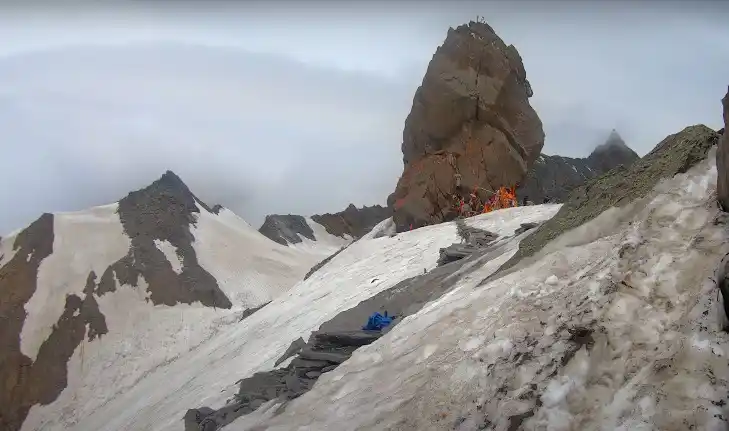
History of Shrikhand Kailash
According to the belief, Lord Shiva took refuge in a cave called Dev Dhank near Nirmand to escape from Bhasmasur. Eventually, Lord Shiva appeared at Shrikhand Kailash Peak. Bhasmasur had received a boon from Lord Shiva that anyone he touched would immediately turn to ashes. At Shrikhand Kailash, Lord Vishnu, disguised as Mohini, enticed Bhasmasur into a dance. While dancing, Bhasmasur placed his hand on his own head and was instantly turned to ashes. It is believed that due to this incident, even today, the soil and water in this area have a reddish appearance.
Shrikhand Mahadev Yatra
The Shrikhand Kailash Yatra is renowned as one of the most challenging pilgrimages in Himachal Pradesh. Spanning a distance of 35 kilometers in one direction, the journey begins amidst dense forests. As you ascend, the trees gradually give way to vast stretches of grassland. Along the path, you’ll be greeted by vibrant flowers and medicinal herbs, creating a picturesque scene. The route is adorned with waterfalls, streams, glaciers, lakes, and boulders, offering a diverse and enchanting experience as you make your way to the summit.
The Yatra is arranged by the Kullu district administration and overseen by the Shrikhand Mahadev Yatra Trust Nirmand. It takes place for a duration of 10 to 12 days in the month of July. Shrikhand Mahadev Yatra 2023 is scheduled to commence on July 7th and will conclude on July 20th. This yatra follows the following path :
Jaon
The pilgrimage commences from a village called Jaon, which serves as the starting point. In Jaon, you will find langars (community kitchens) and accommodation options for staying overnight. It is advisable to spend a night in Jaon to acclimatize before embarking on the yatra. The following morning, you can begin your journey from Jaon.
Singhad
Singhad is located 3 kilometers away from Jaon, and it typically takes around 1 hour to reach there. At Singhad, there is a police post where your registration and medical certificate will be verified. Once the necessary checks are completed, you can proceed further on your journey. To reach Singhad, you will pass through a quaint village, and the trek follows alongside the Kurpan river.
Brahati Nala
Brahati Nala 3kms from Singhad is situated at the meeting point of two streams that make kurpan river. . Following this, a steep incline awaits you. It is important to remember to fill your water bottles at this point, as there won’t be any water source available until Thachru.

Thachdu
Thachdu serves as the first significant stop along the Shrikhand Kailash Yatra. It is located 6 kilometers away from Brahati Nala, and the ascent towards Thachdu is known as “Danda Dhar” due to its steep nature. The journey from Brahati Nala to Thachdu typically takes 6-8 hours to complete. Many pilgrims choose to spend a night at Thachdu to rest and rejuvenate before continuing their yatra.
Kaali Ghati
At the pinnacle of Danda Dhaar lies Kaali Ghati, situated at an altitude of 12,778 feet. From this vantage point, you can relish a breathtaking 360-degree view of the Himalayas. The journey from Taacharu to Kaali Ghat involves a direct ascent of 3 kilometers, which usually takes around 1.5 hours to complete. Along this path, you may encounter the sight of rare Himalayan flowers, adding to the natural beauty of the surroundings.
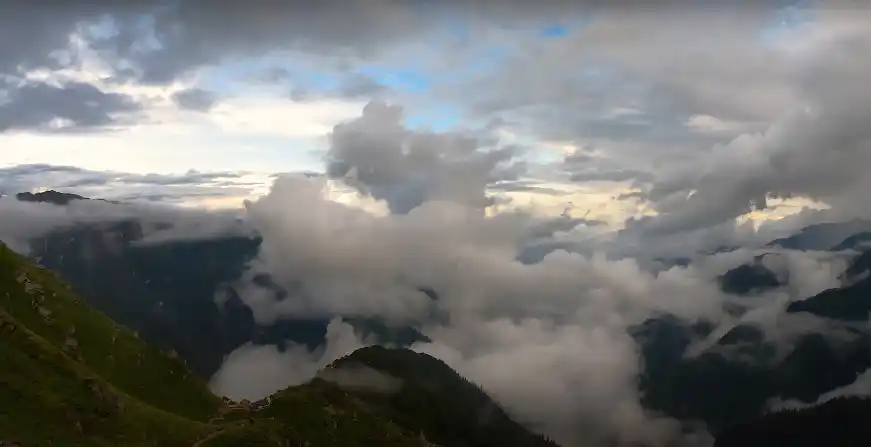
Bheem Talai
Bheem Talai is located approximately 1.5 kilometers away from Kali Ghati, and it is primarily a downhill stretch. According to beliefs, it is said that Bheem, a legendary figure from mythology, used to bathe in this area.
Kunsha
Kunsha is situated an additional 3 kilometers from Bhim Talai, and this particular section of the Shrikhand Kailash yatra is renowned for its extraordinary beauty. As you walk along this path, you will be captivated by the expansive meadows adorned with herbs, flowers, and mountain grass. Along the way, you will come across numerous small streams gracefully flowing beneath the lush cover of thick mountain grass and shrubs.
Bheem Dawar
Bheem Dawar is located 2 kilometers away from Kunsha, and it is a picturesque spot encompassed by magnificent glaciers, enchanting waterfalls, and serene streams. This area is known for its abundance of rare Himalayan shrubs and flowers, offering a delightful sight to behold. According to belief, it is said that the Pandavas, during their period of exile, resided in this very place. As a result, many pilgrims choose Bheem Davari as their overnight stop on the yatra.

Parvati Baag
Parvati Baag is situated 3 kilometers away from Bheem Dwar. on the you will witness the renowned grand waterfall of the Shrikhand Mahadev Yatra. After the waterfall, the path takes a steep ascent. At Parvati Baag, you will have the opportunity to witness the exquisite Braham Kamal, a highly rare flower. According to legends, Lord Shiva himself created this garden for Maa Parvati, hence its name, Parvati Baag. This place is adorned with vibrant, uncommon flowers and flowing streams. pilgrims start their Kailash yatra early next morning.
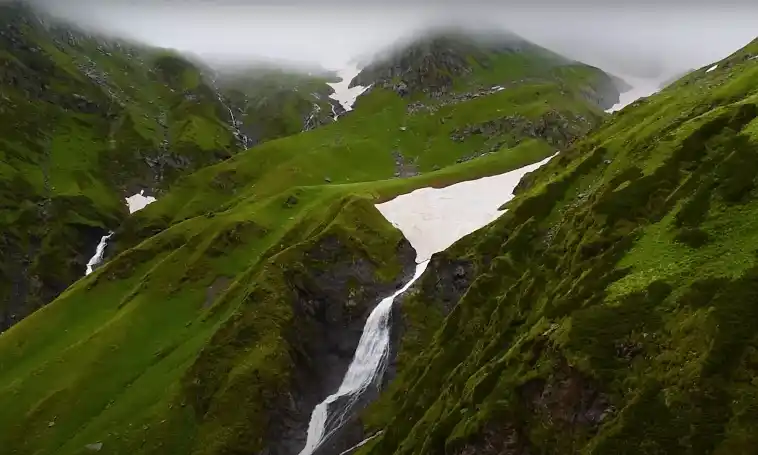
Nain Sarovar
Nain Sarovar is a serene glacial lake devoted to Maa Parvati. Legend has it that this lake came into existence through the tears shed by Maa Parvati while worshipping Lord Shiva. Nain Sarovar is located just 1 kilometer away from Parvati Baag. As you continue your journey from Parvati Baag, the terrain changes to a combination of moraines and snow. The trek towards Nain Sarovar Lake is relatively moderate, with patches of snow and scattered boulders along the way.

Shrikhand Kailash Peak
The final stretch of the Kailash yatra from Nain Sarovar to the Shrikhand Peak spans approximately 6 kilometers and is considered the most challenging part of the journey. This path takes you through vast glaciers, with some sections being narrow and perilously close to the mountain’s edge. It requires tremendous determination and willpower to traverse this route. Along the way, you will come across Bheem Shila, a collection of rocks bearing inscriptions. According to the legends, it is believed that Bheem inscribed mantras on these rocks and threw them upwards towards the mountain, creating a path to heaven.
The Shivalingam
At the summit of Shrikhand Kailash, the Shivlingam is manifested as a colossal rock towering 75 feet in height. Remarkably, the rock formation resembles the head of Lord Shiva. According to tradition, it is advised to abandon one negative habit and adopt a positive one upon reaching this sacred site. From here, a breathtaking panoramic view of Kinnaur and the surrounding mountains unfolds in a 360-degree panorama. Witnessing clouds drifting beneath you, a distinct divine energy engulfs your being, creating a truly transcendent experience.

Kartikeya Peak
From the Shrikhand Mahadev summit, the majestic Kartikeya Peak is visible at a short distance. Despite its proximity, it is said that no one has successfully reached the peak of Kartikeya till date. Any individual who attempts to do so encounters adverse weather conditions and various challenges, making it an arduous task to accomplish.
How to reach Shrikhand Mahadev ?
To reach the village of Jaon, the starting point of the Shrikhand Kailash Yatra, there are several options available. One can either drive their own vehicle or opt for a bus or taxi service. If traveling by bus, there is a bus service available up to Bagipul. From Bagipul, it is a short 3-kilometer walk to Jaon.
For those traveling from Shimla, taking a bus to Rampur is recommended. From Rampur, another bus can be taken to reach Bagipul. Alternatively, if traveling by private vehicle, one can take a left turn approximately 3-4 kilometers before reaching Rampur. This will lead to Nirmand, followed by Bagipul, and finally, Jaon.
Best time to Visit Shrikhand Mahadev
The official yatra for Shrikhand Mahadev takes place for a few days in July, but individuals continue to visit the site until September. According to the locals, the mountain reaches its pinnacle of beauty during September and October. During this time, the entire mountain is adorned with vibrant and colorful flowers, creating a picturesque scene reminiscent of paradise. Every inch of the landscape becomes a canvas of natural beauty, enhancing the overall enchantment of the place.

No of days for Shrikhand Yatra
The minimum no of days required to complete this trek are 4 days.
Day 1 : Jaon – Thachdu
Day 2 Thachdu – Parvati Baag
Day 3 Parvati Baag – Shrikhand Mahadev – Bheem Dawari
Day 4 Bheem Dawar – Jaon
Important Points
You need a registration certificate for the yatra. To register yourself you can click here.
Registration Fee is Rs 250/ person.
Fee once paid will not be refunded.
The official Shrikhand Mahadev yatra 2023 will begin on 7th of July and will go on until 20th July.
Please carry medical fitness certidicate with you.
People above 60 and below 18 are not advised to go on this yatra.
Carry only the necessary load with you. Each gram feels like kilos up there.
Kinnaur Kailash
The Kinnaur Kailash, also known as Kinner Kailash, is a majestic mountain situated in the Kinnaur district of Himachal Pradesh, India. With a towering height of 6050 meters, it holds immense religious significance for both the Hindu and Buddhist communities residing in Kinnaur. At an elevation of approximately 4800 meters, you can find the remarkable monolithic pillar known as the Shivling. This sacred symbol stands as a testament to the spiritual aura and reverence associated with the Kinnaur Kailash.
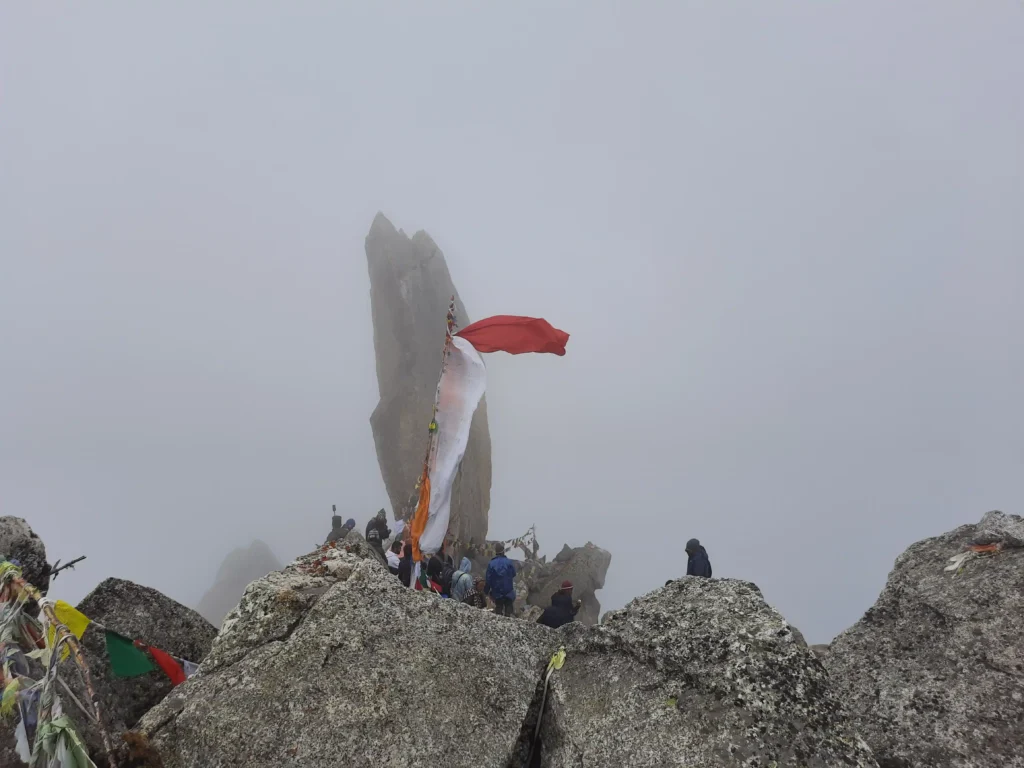
History of Kinnaur Kailash
Kinner Kailash is believed to be the divine abode where Lord Shiva and Mata Parvati reside. This mountain derives its name from the Kinner tribe, who are the native inhabitants of the Kinnaur region. Term “Kinner” holds mythical significance and finds mention in various ancient texts such as the Shiv Purana, Vishnu Purana, Matsya Purana and Ramayan.
Kinner Kailash Yatra
The upcoming Kinnaur Kailash Yatra 2023 is scheduled to commence in July. Kinner Kailash, one of the three revered mountains called Kailash in Himachal Pradesh, attracts pilgrims from far and wide. This annual kailash yatra takes place during the auspicious month of Savan. This Kailash yatra typically begins in late July or early August, and you can find the specific dates on the official website www.hpkinnaur.nic.in
Regarded as one of the most challenging pilgrimages in Himachal Pradesh, the Kinnaur Kailash Yatra covers a distance of 18 kilometers one way, with a significant portion involving a steep ascent. Pilgrims must navigate vertical climbs throughout the journey, adding to the arduous nature of the yatra.
Read Also : Kinner Kailash Yatra 2023 And My Own Thrilling Experience
Pawari Village / Tangling Village
Pawari and Tangling are two villages from where the yatra begins. You can choose any one point to start. Both the villages are beautiful and offers a great view of the reckong peo town. You will find homestays and camps to stay in both the villages.
Ganesh Park
The distance from Tangling to Ganesh Park is approximately 8–9 kilometers, and it usually takes around 8-10 hours to cover this stretch. Ganesh Park serves as the first stop on this yatra. It is an expansive meadow offering breathtaking views of the surrounding mountains. If you’re fortunate, you may even catch a glimpse of the sacred Shivling from this vantage point. There are accommodation options available at Ganesh Park, providing a place to rest for pilgrims undertaking the yatra.

Ganesh Gufa
Located approximately 4 kilometers from Ganesh Park, Ganesh Gufa is a substantial cave tucked beneath a large stone. In the past, this cave provided overnight accommodation for pilgrims undertaking the yatra.
Parvati Kund
Parvati Kund, located approximately 4 kilometers from Ganesh Gufa, is a section characterized by rocky terrain and scattered boulders. Within this region, you will find Parvati Kund, a small pond nestled amidst the immense boulders. This sacred pond is dedicated to Goddess Parvati, and taking a dip in its holy waters is regarded as a holy act. People often toss coins into the pond, hoping that their wishes will be granted.
Kinnaur Kailash Top
The distance from Parvati Kund to the Kailash Top is approximately 1 kilometer, but this segment is considered the most challenging part of the yatra. The oxygen level significantly decreases in this area, and strong winds blow relentlessly. It is advised to maintain a safe distance from other pilgrims to avoid the risk of falling stones. However, reaching the top is a rewarding experience as you witness a magnificent sight—the grand rock Shivlingam perfectly balanced on a stone platform. In the presence of this divine manifestation, one can truly feel a heightened sense of spirituality.

How to reach Shrikhand Mahadev ?
To reach Kinner Kailash one need to reach Reckong Peo which is district headquarter of Kinnaur District. From there on there are two main routes to reach Kinnaur Kailash, one via Pawari village and the other via Tangling village. During our journey, we opted for the route through Pawari village. This particular path offered the advantage of walking approximately two kilometers without much elevation compared to the route through Tangling village, where the ascent begins right from the start. Eventually, both paths converge at a common point along the way.
Route One
ReckongPeo – Pawari Village – Ganesh Park – Gufa – Parvati Kund – Kinner Kailash
Route Two
ReckongPeo – Tangling Village – Ganesh Park – Gufa – Parvati Kund – Kinner Kailash
Best time to Visit Shrikhand Kailash
Best time to visit is during the official kailash yatra which is usually held in july and august. You will find proper facilities during the yatra time.

No. of days required for Kinner Kailash Yatra
For those who are not locals of Kinnaur and experienced trekkers, the minimum duration required to complete the Kinner Kailash yatra is typically three days.
Day 1
Pawari to Ganesh park
Tangling to Ganesh park
Day 2
Ganesh park – Parvati Kund – Kailash- Ganesh Park
Day 3
Ganesh Park – Pawari
Ganesh Park – Tangling
Important Points
Registration is mandatory
Carry registration certificates with you
Carry one photo id proof
Why to go on these Kailash yatras ?
In the heartland of Himachal Pradesh, three sacred mountains stand tall, beckoning devotees from far and wide—the Kinnaur Kailash, Shrikhand Mahadev, and Kinner Kailash. These majestic peaks hold profound spiritual significance, believed to be abodes of Lord Shiva himself. Embarking on these kailash yatras is not just a physical journey but a profound opportunity to connect with the divine.
As you traverse through treacherous terrains, verdant meadows, and cascading waterfalls, the arduous path becomes a path of self-discovery. The magnificent sights of snow-capped peaks, ancient caves, and holy lakes inspire awe and devotion. Each step taken with faith and determination brings you closer to Lord Shiva’s presence.
Though these kailash yatras may test your physical endurance, the rewards are immeasurable. Witnessing the sacred Shivlings, feeling the divine energy, and experiencing the serenity amidst nature’s grandeur instill a sense of spiritual awakening. It is an opportunity to leave behind old habits, embrace virtues, and seek blessings for a transformed life.
So, dear seekers, let the call of Lord Shiva resonate within you. Embrace the challenges, embark on these sacred journeys, and immerse yourself in the divine aura of the three Kailash mountains of Himachal. Allow the essence of Lord Shiva to touch your soul and illuminate your path, for in these sacred yatras, you will find not just physical conquest but a profound connection with the divine.
Also read : Let’s find out top10 Must Do things in Bir Billing
